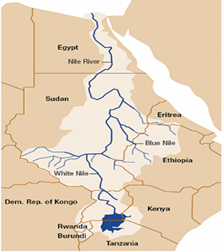

10th September 2025 (16 Topics)
Mains Issues
Context:
The Pradhan Mantri MatsyaSampada Yojana (PMMSY) completes five years of implementation on September 2025, delivering record fish production, rising exports, women’s empowerment, and inclusive growth in the fisheries sector.
Transforming India’s Fisheries through PMMSY
Background and Genesis
- Announced in Union Budget 2019–20, approved by the Cabinet on 20th May 2020.
- Officially launched on 10th September 2020 with an outlay of ?20,050 crore (?9,407 crore Central, ?4,880 crore States, ?5,763 crore Beneficiaries).
- Nodal Agency: National Fisheries Development Board (NFDB).
- Extension approved up to FY 2025–26; as of July 2025, projects worth ?21,274.16 crore
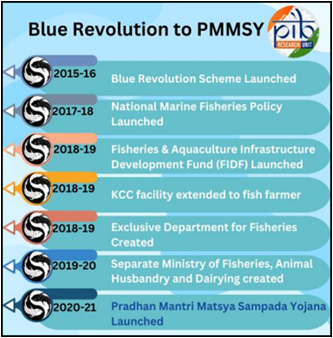
Structure of PMMSY
- Umbrella Scheme with two components:
- Central Sector Scheme (CS): Fully funded by Centre.
- Centrally Sponsored Scheme (CSS): Centre + State funding.
- CSS further subdivided into:
- Production & Productivity Enhancement
- Infrastructure & Post-Harvest Management
- Fisheries Management & Regulatory Framework
Vision and Objectives
- Vision: Ecologically healthy, economically viable, and socially inclusive fisheries sector.
- Objectives:
- Harness fisheries potential sustainably.
- Enhance fish production & productivity.
- Strengthen value chains, post-harvest management, & quality improvement.
- Double fishers’ income & generate employment.
- Enhance exports & Agriculture GVA.
- Provide social & economic security for fishers
Major Achievements (2020–2025)
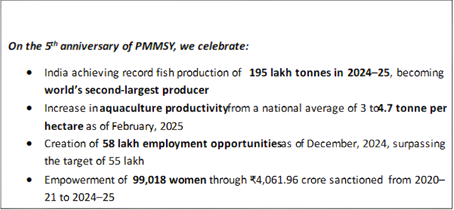
- Production:
- 195 lakh tonnes (2024–25) vs. 141.64 lakh tonnes (2019–20).
- India = 2nd largest fish producer globally, ~8% share.
- Exports:
- Grew from ?46,662.85 crore (2019–20) to ?60,524.89 crore (2023–24).
- Livelihoods & Inclusion:
- ~58 lakh livelihoods created.
- 99,018 women supported with projects worth ?4,061.96 crore.
- Technology Adoption:
- 52,058 reservoir cages, 22,057 RAS &Biofloc units, 1,525 sea cages established.
- 100 Climate Resilient Coastal Fishermen Villages (CRCFV) identified.
- Infrastructure Development:
- ?3,281.31 crore: 58 fishing harbours& landing centres.
- ?1,568.11 crore: ice plants, cold storages, smart markets, kiosks.
- 27,297 post-harvest transport units, 5 digital e-platforms.
Sub-schemes and Digital Transformation
- Pradhan Mantri MatsyaKisanSamridhiSah Yojana (PM-MKSSY):
- Launched in Feb 2024, investment of ?6,000 crore (2023–27).
- Focus: Formalisation, aquaculture insurance, value chain efficiency.
- National Fisheries Digital Platform (NFDP):
- Launched in Sep 2024.
- Single-window system for scheme benefits.
- 7 million+ registrations as of Sep 2025.
Challenges in Fisheries Sector
- Climate vulnerability of coastal communities.
- Overfishing and sustainability concerns.
- Post-harvest losses despite infrastructure push.
- Need for deeper financial inclusion & aquaculture insurance penetration.
- Informal sector dominance limits traceability and global compliance.
Way Forward
- Climate-smart Fisheries: Expand CRCFV model nationwide with early-warning and resilient infrastructure.
- Technology Integration: Promote AI, IoT, satellite-based fishery advisories, and digital traceability.
- Inclusive Growth: Enhanced gender budgeting and targeted support for tribal & coastal vulnerable communities.
- Export Competitiveness: Focus on high-value aquaculture species and certification for global markets.
- Insurance & Credit: Ensure universal aquaculture insurance and easy institutional credit via NFDP.
- Sustainability: Strict monitoring of marine fishing, stock assessment, and responsible aquaculture expansion.


Prelims Articles
Context:
The Union Culture Ministry will host an international conference from September 11–13 to discuss attempts to decipher the Harappan script and understand its underlying language.
Background
- Harappan Script: Found in Harappa and Mohenjo Daro (Indus Valley Civilization, c. 2500–1900 BCE).
- Undeciphered Language: Despite nearly a century of research, no universally accepted decoding exists.
- Significance: Understanding the script can reveal insights into trade, administration, religion, and socio-cultural life of Harappan civilization.
The Conference
- Dates: September 11–13, 2025
- Objective: Share findings, present papers, and explore the Dravidian, Sanskrit, and Adivasi language hypotheses.
Theories on Harappan Language
- Sanskrit Hypothesis: Some scholars argue the underlying language was proto-Sanskrit.
- Dravidian Hypothesis: Others link it to Dravidian languages, especially Santali and Gondi.
- Bilingual Object Hypothesis: Deciphering becomes easier if the script appears on bilingual artifacts (e.g., coins with Brahmi).
- Political Aspect: Tamil Nadu announced a $1 million reward for deciphering, highlighting the script’s political and cultural significance.
Challenges in Decipherment
- Short inscriptions, lack of bilingual texts
- Contextual ambiguity (e.g., trade vs ritual use)
- Interdisciplinary research required (linguistics, archaeology, anthropology, computational methods)
Notable Contributions & Methods
- Karuna Shankar Shukla, Prakash N Salame, and others have attempted decoding using Proto-Dravidian roots, tribal languages, and root morphemes.
- Computational and software-assisted approaches are being explored.
- Recent research matches Harappan symbols with Rigveda and other Vedic texts for possible linguistic links.


Prelims Articles
Context:
C.P. Radhakrishnan, Governor of Maharashtra, was elected as the 17th Vice-President of India on September 2025.
Constitutional Position
- The Vice-President is the second highest constitutional office in India (after the President).
- Mentioned under Articles 63–71 in Part V of the Indian Constitution.
- Serves as the ex-officio Chairperson of the Rajya Sabha, reflecting the principle of separation between the Legislature and the Executive.
- Unlike the President, the Vice-President does not perform executive functions, except when acting as the President in temporary vacancies.
Term and Tenure
- Normal tenure is 5 years(Article 67), but continues until the successor assumes charge.
- May resign by submitting resignation to the President of India.
- Removal:
- By a resolution of the Rajya Sabha, passed by an effective majority (i.e., majority of the then members of Rajya Sabha).
- Must be agreed to by the Lok Sabha (simple majority).
- Prior notice of at least 14 days is mandatory.
Qualifications (Article 66 & 67)
- Must be a citizen of India.
- Must have completed 35 years of age.
- Must be qualified for election as a member of the Rajya Sabha.
- Must not hold any office of profit under Union, State, local, or public authority (to ensure neutrality and independence).
Electoral College
- Article 66 provides that Vice-President is elected by an Electoral College, consisting of:
- Elected members of Rajya Sabha,
- Nominated members of Rajya Sabha,
- Elected members of Lok Sabha.
- Note: Unlike the President’s election, state legislatures have no role in electing the Vice-President.
Election Process
- Supervised by: Election Commission of India (Article 324).
- Law governing election: Presidential and Vice-Presidential Elections Act, 1952, and Rules, 1974.
- Notification: Issued not earlier than 60 days before expiry of the term.
- Returning Officer: Secretary-General of Lok Sabha or Rajya Sabha (by rotation).
- Polling Venue: Parliament House, New Delhi.
- Vote Value: Since all electors are MPs, each MP’s vote value is 1 (unlike the Presidential election, where vote value varies).
- Method: Proportional Representation by means of Single Transferable Vote (STV), by secret ballot.
Functions
- Presides over Rajya Sabha sessions (like the Speaker in Lok Sabha).
- Maintains order, decides on procedural matters, and ensures smooth functioning of the House.
- Cannot vote in Rajya Sabha except in case of a tie (casting vote).
- Acts as President of India when:
- Vacancy arises due to death, resignation, removal, or incapacity of the President (for maximum 6 months, until new President is elected).
Key Distinctions from the President
- Electoral College:
- President: Includes both MPs and MLAs of States/UTs.
- Vice-President: Only MPs (both elected and nominated).
- Role:
- President: Executive Head of State.
- Vice-President: Primarily legislative role as Rajya Sabha Chairperson.
- Removal:
- President: Impeachment process involving both Houses with a special majority.
- Vice-President: Simple resolution of Rajya Sabha agreed by Lok Sabha.


Prelims Articles
Context:
The Supreme Court is examining whether specific timelines can be imposed on Governors and the President to grant assent to State Bills, following a Presidential Reference.
Constitutional Role of Governors
- Governors are constitutional authorities under Articles 200, 201, and 153–167.
- They act as a link between the State and Union and are expected to be “true guides and philosophers” for State governments.
- Their assent to Bills is a constitutional requirement for legislation to become law.
Current Issue
- States like Kerala, Tamil Nadu, Punjab, Telangana, and West Bengal have faced delays of 7–23 months in Bill assent.
- Other States generally accord timely assent, indicating collaborative functioning is possible.
Legal and Advisory Context
- Presidential Reference: Supreme Court is interpreting whether timelines can be imposed on Governors/President under Articles 200 (Bills reserved for Governor’s assent) and 201 (Bills reserved for President’s assent).
- Past precedent: April 8 judgment on Tamil Nadu Governor established three-month deadlines for assent.
- Advisory jurisdiction under Article 143 allows the Court to provide guidance to the President on constitutional matters.
Governance Implications
- Delays in assent disrupt the legislative process and affect governance.
- Ensuring timely assent preserves constitutional balance between legislature, executive, and Governor.
- Over-specification of timelines may risk litigation proliferation, as seen in medical admission cases.


Prelims Articles
Context:
The Rajasthan Assembly passed the Prohibition of Unlawful Conversion of Religion Bill, 2025, introducing stringent penalties including life imprisonment and fines up to ?1 crore for forcible or fraudulent conversions.
Key Provisions of the Bill
- Offences are cognisable, non-bailable, and triable by the Sessions Court.
- Marriages undertaken solely for conversion are declared void; conversions before or after such marriages are unlawful.
- Exemption is provided for individuals returning to their “ancestral religion.”
Historical and Judicial Background
- A similar Bill was attempted in 2006 under CM Vasundhara Raje but was returned by President Pratibha Patil.
- Rajasthan High Court in 2017 issued guidelines: only adults can convert, with prior intimation to the District Magistrate and public notice.
- Earlier attempts in 2008 were stalled at the Centre amid opposition from minority groups and civil society.
Comparative Federal Context
- Rajasthan now joins States like Uttar Pradesh, Haryana, Uttarakhand, Arunachal Pradesh, and Andhra Pradesh in enacting such laws.
- These legislations generally aim at curbing conversions through force, fraud, allurement, or marriage.
- They derive constitutional support from Article 25(1) (freedom of conscience and right to freely profess, practice, and propagate religion) but are subject to restrictions on grounds of public order, morality, and health.


Prelims Articles
Context:
The Employees’ State Insurance Corporation (ESIC) has launched SPREE-2025 and the Amnesty Scheme-2025 to expand social security coverage and simplify compliance for industries.
SPREE-2025:
- Full form: Scheme for Promoting Registration of Employers and Employees.
- Duration: Till 31st December 2025.
- Features: Employers and employees can register on the ESI Portal, Shram Suvidha Portal, and Company Affairs Portal without demand of old dues.
- Benefit: Employers covered from date of registration; employees receive ESI health and social security benefits from registration date.
Amnesty Scheme-2025:
- Duration: 1st October 2025 to 30th September 2026.
- Aim: A one-time dispute resolution scheme under the ESI Act.
- Coverage: Settlement of issues relating to damages, interest, and coverage disputes.
- Impact: Reduces litigation, promotes compliance, and ensures smoother delivery of social security benefits.
Significance:
- Expands the ambit of formal social security coverage.
- Encourages voluntary compliance over punitive enforcement.
- Provides relief to industries, particularly MSMEs, from litigation burden.
- Reinforces government’s commitment towards labour welfare and ease of doing business.


Prelims Articles
Context:
NITI Aayog and the City of London Corporation released the Year-1 report of the UK-India Infrastructure Financing Bridge (UKIIFB) on 9 September 2025, charting steps to mobilise long-term sustainable finance for Indian infrastructure.
UK–India Infrastructure Bridge
- UKIIFB is a bilateral initiative led by NITI Aayog and the City of London Corporation to improve investability of large infrastructure projects in India by leveraging UK expertise in project structuring and patient capital.
- Key Year-1 deliverables: The report presents a Project Assessment Framework (clarifying investor priorities for highways/rapid transit), integrates climate-resilience and ESG into project design, and recommends transparency and revenue-protection measures to reduce perceived risk.
- Project preparation & DPR recommendations: It urges standardised, globally-benchmarked project preparation (DPRs to include full-lifecycle risk analysis, resilience and value-for-money), and stronger risk-sharing/revenue protection to attract long-term investors.
- Sectoral & digital focus: The report highlights building investor-centric project pipelines, using digital monitoring for governance, and expanding sector coverage (Year-2 emphasis on areas such as green hydrogen and offshore wind).
- Why it matters for India: By addressing investability gaps, UKIIFB aims to mobilise “patient capital” needed for large infrastructure that underpins urbanisation, climate commitments and economic growth. Improved project bankability helps reduce the financing shortfall for the National Infrastructure Pipeline and similar initiatives.


Prelims Articles
Context:
National Co-operative Exports Limited (NCEL) and Agricultural and Processed Food Products Export Development Authority (APEDA) signed an MoU to promote cooperative-led agricultural exports.
National Co-operative Exports Limited (NCEL)
- Establishment: Set up in January 2023 under the Multi-State Cooperative Societies (MSCS) Act, 2002.
- Nature: An umbrella export body promoted by the Government of India under the Ministry of Cooperation.
- Objective:
- To promote exports of products from cooperative institutions, farmers’ collectives, and rural enterprises.
- To increase farmers’ income by linking them with global markets.
- Functions:
- Export of agricultural produce, dairy products, handloom, handicrafts, textiles, fisheries, and allied products.
- Capacity building of cooperative societies to meet international quality standards.
- Support in branding, marketing, logistics, and certification.
- Special Feature: Functions as a trusted agency to ensure that small producers and cooperatives directly benefit from exports, bypassing middlemen.
- Significance: Strengthens the “Prosperity through Cooperation” (Sahkar se Samriddhi)
Agricultural and Processed Food Products Export Development Authority (APEDA)
- Establishment: Formed in 1986 through an Act of Parliament.
- Nodal Ministry:Ministry of Commerce and Industry.
- Objective: To promote and develop the export of scheduled agricultural and processed food products.
- Key Functions:
- Registration of exporters of scheduled products.
- Development of infrastructure for agri-exports (pack houses, cold chains, quality testing labs).
- Promotion through trade fairs, buyer-seller meets, brand promotion.
- Capacity building for farmers and exporters on packaging, food safety, certification (like GI, Organic, HACCP).
- Scheduled Products: Includes fruits, vegetables, processed foods, meat, poultry, dairy products, cereals, basmati rice, alcoholic and non-alcoholic beverages, honey, sugar, etc.
- Special Role:
- Nodal agency for India’s participation in Global food fairs (e.g., Gulfood, SIAL, Anuga).
- Acts as a bridge between farmers and international markets.
- Significance: Enhances India’s share in global agri-trade and promotes value-added agri-exports.


Prelims Articles
Context:
The Investor Education and Protection Fund Authority (IEPFA) celebrated its 9th Foundation Day on 8th September 2025 with a Round Table Conference on unlocking the potential of idle financial assets.
Investor Education and Protection Fund Authority (IEPFA):
- Establishment and Nodal Ministry: IEPFA was established on 7th September 2016 under the Ministry of Corporate Affairs (MCA).
- Core Function: It manages the Investor Education and Protection Fund (IEPF), which facilitates refunds of shares, unclaimed dividends, matured deposits, debentures, and related amounts transferred to the fund under the Companies Act.
- Investor Protection: It safeguards investor rights by simplifying claim settlements and ensuring transparent, technology-enabled processes. Recent reforms include the Integrated Portal for Claims and Refunds and faster low-value claim processing.
- Financial Literacy Initiatives: IEPFA conducts drives such as Niveshak Didi, NiveshakShivirs, and is launching NiveshakSamadhan – Dial Your CEO.
- Policy Significance: Unclaimed assets, if unlocked, can strengthen financial inclusion, improve liquidity in the system, and enhance investor confidence.
- Vision: IEPFA’s “Panchtattva Vision” focuses on transparency, technology, trust, faster refunds, and AI-driven solutions to position itself as a trust anchor of India’s financial ecosystem.


Prelims Articles
Context:
The Union Ministry of Tribal Affairs has sought a factual report from the Andaman and Nicobar administration after the Tribal Council alleged non-settlement of forest rights under the FRA, 2006, prior to diversion of land for the Great Nicobar Project.
Great Nicobar Project
Project Overview 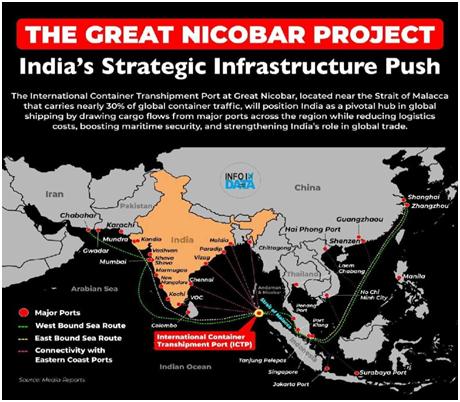
- Name: Great Nicobar Project
- Type: Multi-development initiative
- Timeline: Phased development over 30 years
- Clearance: Ministry of Environment, Forest and Climate Change (MoEFCC), Nov 2022
- Estimated Cost: ?72,000 crore
- Purpose: Strategic infrastructure development, economic growth, and enhanced security presence in the Andaman and Nicobar Islands
Strategic Importance
- Enhances India’s strategic presence in the southern Bay of Bengal.
- Counters expansionist activities by China in the Indo-Pacific region.
- Secures maritime interests and monitors illegal fishing/poaching (particularly by Myanmar).
- Supports India’s Look East/Act East Policy and maritime domain awareness.
Key Infrastructure Components
- International Container Trans-shipment Terminal – to handle global shipping traffic.
- Greenfield International Airport – dual-use (civilian and military) for strategic mobility.
- Township Development – supporting residential and commercial needs.
- Power Plant (450 MVA) – hybrid model: gas and solar-based.
- Transportation Networks – roads, ports, and logistic facilities.
Geographical and Ecological Context
- Location: Southernmost island of the Andaman and Nicobar group; near Indira Point (<150 km from Indonesia).
- Topography: Mountain ranges up to 650 m, tropical wet evergreen forests, coastal plains.
- Protected Areas: Two national parks and a biosphere reserve.
- Biodiversity: Home to endangered species like leatherback sea turtles, endemic flora and fauna.
Indigenous Tribes and Social Considerations 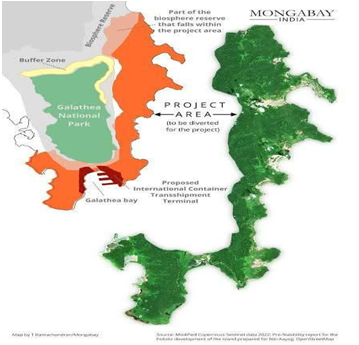
- Shompen Tribe: ~237 members, hunter-gatherers; reside in tribal reserve.
- Nicobarese Tribe: ~1,094 members; part of the tribal reserve.
- Land Impact: 84 sq km proposed for denotification out of 751 sq km tribal reserve.
- Concerns: Cultural displacement, loss of traditional livelihoods, protection of tribal rights under Scheduled Tribes and Other Traditional Forest Dwellers (Recognition of Forest Rights) Act, 2006.
Environmental Impacts
- Deforestation: 13,075 hectares (15% of island area); ~9.64 lakh trees to be cut.
- Ecosystem Risk: Threat to forests, mangroves, wildlife habitats, and endemic species.
- Mitigation: Environmental management plans, compensatory afforestation, biodiversity conservation measures.
Seismic and Disaster Considerations
- Seismicity: High-risk zone; 2004 earthquake (9.2 Richter) affected region.
- Risk Assessment: Major earthquakes unlikely for 400–750 years; smaller tremors expected.
- Structural Safety: All infrastructure will adhere to National Building Code (NBC) earthquake-resistant norms.


Prelims Articles
Context:
Kerala’s first State-level Urban Policy Commission (KUPC) submitted its 25-year urban roadmap in March 2025, proposing systemic reforms for climate-resilient, citizen-centered urbanization.
Background
- Kerala exhibits “rurban” settlements — villages, towns, and backwaters blend seamlessly.
- Urban population projected to exceed 80% by 2050, stressing infrastructure and governance.
- Climate threats: floods (Ernakulam), landslides (Western Ghats), coastal erosion.
- KUPC formed in Dec 2023 as India’s first State-level urban commission to provide a tailored, proactive urban policy.
Objectives of KUPC
- Treat cities as climate-aware ecosystems.
- Integrate citizen experiences with scientific data.
- Enable fiscal empowerment of municipalities via bonds and green levies.
Methodology
- 33 deep-dive studies: land-use, water systems, finance, civic health.
- 53 district-level stakeholder dialogues with local authorities, NGOs, residents, gig workers.
- Use of Census, satellite imagery, LIDAR, radar, tide/water gauges, and real-time weather data.
Key Recommendations
- Climate and Risk-Aware Zoning: Urban planning incorporates flood, landslide, and coastal hazard mapping.
- Digital Data Observatory: Real-time municipal intelligence at Kerala Institute of Local Administration (KILA).
- Financial Instruments: Green fees for eco-sensitive zones; parametric disaster insurance; municipal and pooled bonds.
- Governance Overhaul: City cabinets led by mayors; specialist cells; youth tech talent via “Jnanashree” program.
- Place-Based Economic Revival: Thrissur-Kochi: FinTech hub; Thiruvananthapuram-Kollam: Knowledge corridor; Kozhikode: Literature city; Palakkad & Kasaragod: Smart-industrial zones.
- Commons, Culture, and Care: Wetland revival, waterways, heritage preservation; city health councils for migrants, students, gig workers.
Unique Features
- First sub-national commission tailored to Kerala’s socio-ecological realities.
- Citizen-generated data integrated into policy.
- Climate resilience embedded in all pillars.
- Fiscal autonomy via bonds and levies.
- Governance combines elected leadership and youth technocrats.


Prelims Articles
Context:
An Indian Armed Forces contingent has departed to participate in the multilateral joint military exercise ZAPAD 2025 in Russia from 10 to 16 September 2025.
ZAPAD 2025:
- Exercise Overview: Exercise ZAPAD 2025 is a multilateral joint military exercise conducted at the Mulino Training Ground, Nizhniy, Russia, focusing on conventional warfare and counter-terrorism operations.
- Indian Contingent Composition: 65 personnel — 57 from the Indian Army, 07 from the IAF, and 01 from the Indian Navy. The contingent is led by a battalion of the Kumaon Regiment with other supporting arms and services.
- Objective: To enhance interoperability, military cooperation, and facilitate the exchange of tactics, techniques, and procedures in multinational environments.
- Operational Focus: Exercises include joint planning, tactical drills, special arms skills, and missions at company-level operations in open/plain terrain.
- Strategic Importance:
- Reinforces India–Russia defence cooperation and trust.
- Positions India as an active participant in multinational security collaborations.
- Strengthens preparedness in joint operations with emerging technologies.


Prelims Articles
Context:
Ethiopia inaugurated the Grand Ethiopian Renaissance Dam (GERD), Africa’s largest hydroelectric project, sparking protests from downstream nation Egypt over water security concerns.
Project Overview
- Name: Grand Ethiopian Renaissance Dam (GERD)
- Location: Blue Nile near Sudanese border, Ethiopia
- Dimensions: 170 m tall, 1.9–2 km long
- Cost & Capacity: $4 billion; 5,150 MW electricity; 74 billion cubic metres water storage
- Construction: Began in 2011; inaugurated 2025
Significance for Ethiopia
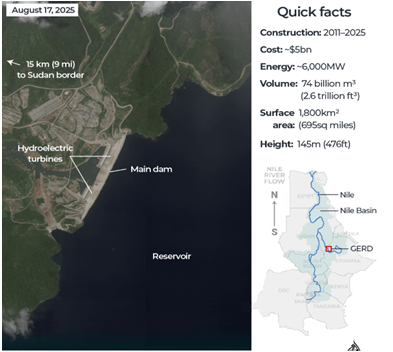
- Hydropower: Largest electricity-generating dam in Africa; potential to transform Ethiopia into a regional power hub
- National Pride: Seen as a unifying symbol amid internal conflicts
- Regional Influence: Strengthens Ethiopia’s strategic leverage in the Nile Basin
Downstream Concerns (Egypt & Sudan)
- Egypt: Relies on Nile for ~97% of freshwater; calls GERD an “existential threat”
- Legal Claim: Protested to UN Security Council citing violation of international law
- Water Security: Fear of reduced water flow affecting agriculture, industry, and population
Geopolitical Context
- Nile River Dispute: Long-standing tensions among Nile Basin countries (Egypt, Sudan, Ethiopia) over water rights
- Regional Diplomacy: GERD influences Ethiopia-Sudan-Egypt relations; international mediation has often been attempted
Environmental & Developmental Aspects
- Renewable Energy: Hydropower reduces dependence on fossil fuels
- Economic Growth: Supports industrialization and energy exports
- Environmental Concerns: Potential impacts on downstream ecosystems and agriculture
|
NILE RIVER
Major Branches
Hydrological & Geopolitical Significance
|


Editorials
Context:
India marked its 79th Independence Day (15th August 2025), highlighting the urgent need for technological independence to safeguard national security and digital autonomy.
Software Sovereignty
- Dependence Risk: India lacks indigenous operating systems, databases, and foundational software, leaving it vulnerable to external control and disruptions in cloud or AI services.
- Open-Source Potential: Open-source models such as Linux and Android provide a viable path to create safe, backdoor-free Indian versions of essential digital platforms.
- Community Role: A large technology user base and professional collaboration are essential for building, maintaining, and updating secure home-grown software ecosystems.
Hardware Sovereignty
- Structural Challenge: Achieving hardware sovereignty, especially in semiconductor fabrication, demands long-term investment in design, manufacturing, and supply chain infrastructure.
- Focused Strategy: India should initially target specific hardware components, fostering expertise in chip design and assembly even if fabrication remains outsourced.
- Collaborative Approach: Public-private partnerships and international cooperation can gradually strengthen India’s position in advanced hardware technologies.
The Way Forward
- Mission-Oriented Plan: Establishing an implementation mission with skilled engineers and strong project management is vital to build self-sustaining technological ecosystems.
- Business Model: Viable business models, outside sole government dependence, must ensure continuous development, updates, and financial sustainability of open-source systems.
- National Resolve: A collective will, combining talent, institutions, and supportive policies, is essential for India’s long-term march toward technological independence.
Practice Question:
"Technological sovereignty is as vital as political sovereignty in the 21st century. Discuss the challenges and opportunities for India in achieving software and hardware independence, and suggest a policy roadmap." (250 words)


Editorials
Context:
The Supreme Court has directed the Election Commission of India (ECI) to include Aadhaar as a valid document for enrolment in Bihar’s electoral roll, correcting an exclusionary approach.
Background and Significance
- Electoral Integrity: The credibility of the Election Commission rests on the principle that every citizen, irrespective of status, has the right to vote.
- Aadhaar’s Role: Aadhaar, being India’s most widely used proof of identity, offers biometric verification that supports electoral transparency.
- Supreme Court Intervention: By mandating Aadhaar’s inclusion, the Court rectified a major discrepancy in Bihar’s Special Intensive Revision (SIR) process.
Challenges in Electoral Revision
- Exclusion Concerns: Past practices of door-to-door verification often placed the burden of proof on citizens, risking wrongful exclusion from the rolls.
- Flawed Approach: Bihar’s rushed SIR process focused more on excluding non-citizens than on ensuring the inclusion of genuine voters.
- Legal and Social Risks: Denial of Aadhaar in voter enrolment indirectly undermined the constitutional guarantee of universal adult suffrage.
The Way Forward for ECI
- Procedural Reforms: The ECI must adopt robust verification and regular revision processes that ensure accuracy without being exclusionary.
- Spirit of Inclusion: Aadhaar should be treated as an additional document of facilitation, not as proof of citizenship, aligning with democratic principles.
- Institutional Credibility: By implementing the SC’s directive, the ECI can restore public trust and uphold its record as an impartial guardian of free elections.
Practice Question:
"The Supreme Court’s recent directive to include Aadhaar as a valid document for electoral enrolment highlights the balance between electoral integrity and inclusiveness. Critically examine the implications of Aadhaar’s use in voter rolls for democracy and electoral reforms in India." (250 words)


Editorials
Context:
Mass protests led by Nepal’s young generation against governance failures and digital restrictions have created political instability with direct implications for India.
The Gen Z Uprising
- Trigger of Protest: The blackout of social media platforms in Nepal acted as the immediate spark, mobilising a digitally active youth against corruption and misgovernance.
- Youth Demographic: With over 40,000,000 internet users and a median age of 24, Nepal’s youth form a decisive political force demanding accountable governance.
- Systemic Failures: Frequent changes of government, blurred governance lines, and entrenched corruption have eroded legitimacy, fueling discontent among young citizens.
Regional Consequences for India
- Spillover Risks: Any collapse of Nepal’s state capacity will impact India directly, especially in Bihar, Uttar Pradesh, Sikkim, and Uttarakhand through migration and instability.
- Historical Lessons: Experiences from Bangladesh show that youth-driven unrest can quickly transform into anti-India sentiment if New Delhi is perceived as interfering.
- Strategic Vulnerability: A politically unstable Nepal risks becoming a ground for external actors, threatening India’s security and regional stability.
The Way Forward for India
- Listening Approach: India must engage with Nepal’s youth voices through cultural exchanges, scholarships, and educational partnerships to build trust.
- Supportive Role: Assistance in digital infrastructure, governance reforms, and institutional strengthening should be extended discreetly, not as prescriptive intervention.
- Strategic Patience: By avoiding overt political involvement and instead fostering people-to-people ties, India can reinforce long-term goodwill and stability in Nepal.
Practice Question:
"India’s strategic partnership with Nepal is being tested by the recent youth-led protests and governance crisis. Discuss the implications for India’s internal and external security, and evaluate the role New Delhi should play in supporting democratic reforms in Nepal." (250 words)


